Future Trends: Influence in the Age of Social Media
25 Jan 2022

The last two years have been a collection of many unprompted changes. At the beginning of 2020, within just a few months, we learnt that the digital world was the new (and often the only) way to connect.
Both customers and brands have been asked to quickly adapt and learn how to interact in a new space with new rules. However, with the gradual lifting of the restrictions, stores started to re-welcome people with the urgency to integrate the digital universe into customers’ real-life experiences and vice versa.
Therefore, now that we live in this hybrid world, what does ‘influence’ look like? How do the nudges customers receive from the digital universe influence their behaviour?
What are the main changes – in terms of consumers’ actions and mindset – in a more social media-managed world?
These are just some of the questions we answer in this first article of the Customer Engagement: Future Trends 2022 series, sponsored by dotdigital, Merkle and Salesforce and in partnership with Foresight Factory. Identifying the challenges brands are facing today and shedding light on what winning influence strategies will look like tomorrow.
The Trend
Social media has fast become a ubiquitous part of consumers' lives, with many more customers increasingly engaging with one or more of these platforms every day. Foresight Factory’s forecast sees the overall number of social media users continuing to increase, despite the number of customers engaging with specific platforms fluctuating.
Customers who have used social networking sites in the last six months (adjusted for internet penetration)

Different age groups interact differently with their social media, but most customers are getting more familiar with these platforms and integrating them across different moments in their purchase journey.
Indeed, while social media penetration was near saturation among younger consumers aged 16-34, the pandemic has brought an unprecedented rise among older consumers too.
Customers who have used social networking sites in the last six months (adjusted for internet penetration)
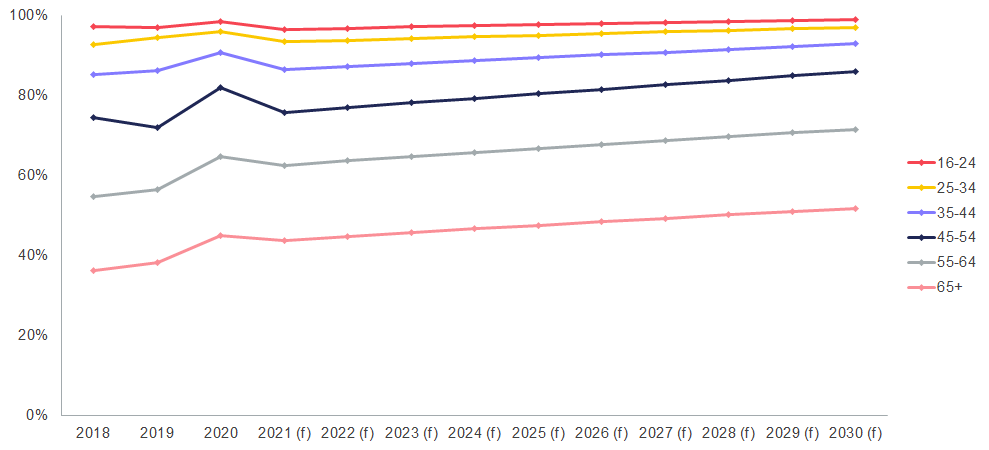
In 2021, Foresight Factory’s data shows Facebook was the most popular social channel among UK consumers, used by seven in 10 consumers on average. The social network was rated as the top channel among Gen X (74%) and Baby Boomers (62%) in particular.
YouTube was the most-used channel among Millennials (84%) and Gen Z (91%).
TikTok became increasingly popular amid the pandemic, especially among Gen Z (63%). But data shows a 17% uptake of the video platform across the general public too – from just 2% in 2019 to 19% in 2021.
Younger consumers are also highly familiar with Snapchat, with 77% of Gen Z using it in 2021 compared with just 20% of the total UK population.
So, what’s the role these platforms play when it’s about influencing customers and their purchasing decisions? What’s the outcome of brands’ investment in their digital channel strategy?
Nearly a third (29%) of consumers said the adverts they find on social media are more interesting than those they see elsewhere – a statement that resonated with more than half of the young respondents aged 14-24 (52%) and 25-34 (54%).
Even among the older 56-64 age group the number who find social media adverts powerful has increased in the last two years too – doubling from 6% in 2019 to 12% in 2021.
Furthermore, the data reports a stronger agreement among Instagram users (51%) rather than Facebook users (36%).
How much do you agree or disagree that “Adverts I see on social media are more interesting than those I see elsewhere”? (% agree)
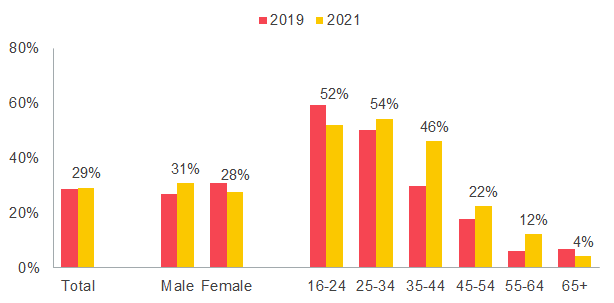
Within Acquisition and the Consumer Mindset 2021 report, we explored the role played by a few digital channels when it comes to brand discovery. Three of the areas that were investigated included social media, Google Ad search, and podcast.
Two out of five customers (40%) mentioned they have discovered new brands through social media adverts – an increase that has also been seen in older customers too in the last year. In particular, customers with a higher yearly income (£75,000+) have defined social media platforms as a great way to discover new businesses.
Promoted Google Ad search results came out almost as powerful as social media adverts. Indeed, 35% of customers found them useful to discover new brands – with an 11% increase in the number of those aged 35-44 between 2019 (39%) and 2021 (52%).
Finally, podcast advertising also turns out to be a good media to boost brand discovery. In 2021, a quarter of the total number of customers (25%) said the channel allowed them to learn about new businesses. This is particularly true for those aged 35-44 (from 29% in 2019 to 44% in 2021) who seem to have relied on their favourite podcasts to discover new brands more than the other age cohorts.
Brand discovery via digital channels
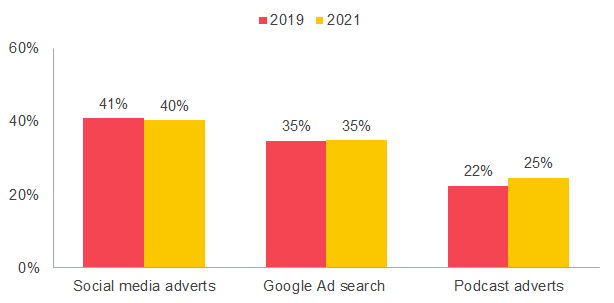
As the data shows, social media platforms are powerful in attracting consumers’ attention – but their interest isn’t enough, trust issues need to be faced and solved.
In a world submerged by ambiguity and distrust, where information is more available than the filters and tools to understand it and recognise its veracity, consumers look for new ways to validate commercial claims. As shown in the following chart, 54% of UK consumers say they find it difficult to know what information to trust online, a sentiment which skews women (57%) and men (51%).
How strongly do you agree or disagree with the following statements? I find it difficult to know what information to trust online
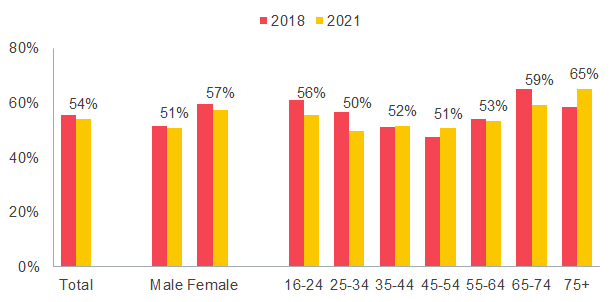
In 2018, 69% of UK consumers reported that brands should do more to prove their product claims – a sentiment felt even more strongly among Gen Z (80%). Furthermore, in 2019, 49% felt the need to find better ways to evaluate the quality of products/services they buy (up from 39% in 2011).
On this, there is some good news to reveal, as according to the 2021’s Edelman Trust Barometer report, globally businesses are the only type of institution seen as both competent and ethical (compared with government, NGOs and media). In other words, despite the rising distrust with consumers questioning the validity of the information surrounding them, businesses and brands are held in higher regard compared to other key institutions in consumers’ lives.
Therefore, it’s key that brands ensure openness and transparency to address trust issues to fully capitalise on the opportunities and benefits digital channels offer.
The Insights
Social media as digital storefronts
Today, social media are not only platforms where consumers can catch up on the latest news and stay up-to-date with their friends’ lives, but also discover and buy products – all within a single feed. At the moment, Facebook, Instagram and Pinterest are the top-of-mind examples, but Twitter and TikTok are also experimenting with shoppable content.
Shopping is becoming more integrated into our daily lives and social media is an effective touchpoint where interactively and spontaneously consumers can discover new brands. As it feels more organic and authentic than other forms of retail, social media shopping satisfies consumers’ desire to seek out genuine experiences.
Which of these things have you done already? Bought something directly through a social media site
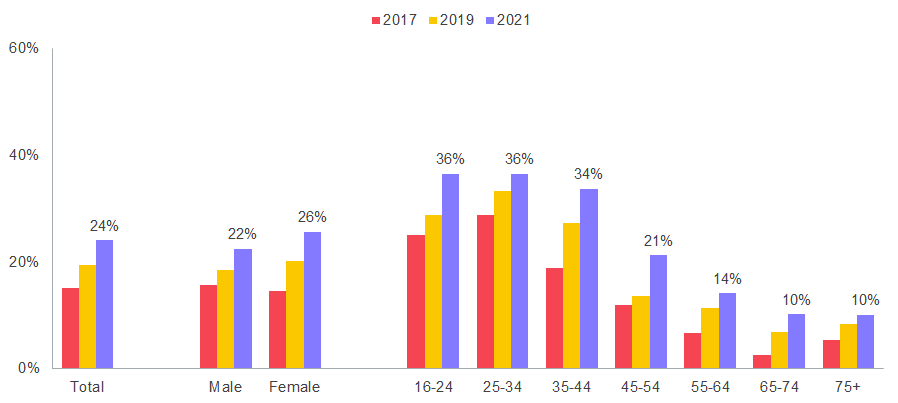
As the chart shows, buying through a social media platform is an emerging behaviour – in 2021 24% of UK consumers said they had bought something directly through a social media site, compared to 15% in 2017. Uptake is slightly higher among women (26%) than men (22%) and younger customers – likely due to social media usage being generally higher among younger consumers.
The increased amount of time people spent on these platforms during the pandemic is a key factor that boosted the transformation of social media into e-commerce. Indeed, in March 2021, 33% of UK consumers said they were planning to shop online more in the following 12 months compared to pre-pandemic and 56% said they would have kept doing the same amount of online shopping.
By 2030, Foresight Factory predicts 35% of the UK population could be buying directly from social media, and a further 16% interested in doing so.
Live shopping, already popular in Asia and EMEA, may also be the next step for social commerce. It offers brands opportunities to create that sense of urgency while also letting consumers purchase directly from streams.
The influencer's power
Paraphrasing Wired’s definition, influencers are public characters who “have the power to affect the buying habits and actions of others by sharing some form of original content to social media platforms.”
Instagram and YouTube are home to influencers with a large crowd of followers and high engagement metrics, but TikTok has recently grown significantly in recent years with its focus on ‘micro-influencers’.
Health, technology, travel and cookery are the sectors where influencers have had a strong impact already. As consumers are always after expert advice, predictions are that other areas will have opportunities for the next generation of influencers to grow too, such as education and finances. By 2025, Foresight Factory forecasts that 36% of UK consumers will follow online influencers for inspiration, with a further 9% interested in doing so.
In the Influencer Marketing Benchmark 2021 report the predictions are that the influencer marketing industry will grow to US$13.8 billion in 2021, up from US$1.7 billion in 2016. Among the surveyed experts, 90% believe influencer marketing is an effective form of marketing – 67% use Instagram for influencer marketing with a strong increase in TikTok influencer marketing too.
Furthermore, most brands use the same influencers across different campaigns and 67% prefer their influencer marketing to be campaign-based rather than always-on.
Which of these things have you done already and which are you interested in doing in the future? Followed an online influencer/s for inspiration

Data from the Influencer Marketing Benchmark 2021 has also highlighted that finding influencers remains the most significant challenge (34%) for those who run campaigns in-house, but is becoming slightly less of a problem (challenge mentioned by 39% of respondents in 2019).
If earlier we spoke about challenges related to consumers’ trust in brands and their message, in the influencer space we find marketers dealing with similar difficulties too. Indeed, influencer fraud is still a concern for many (67%) despite far fewer respondents having experienced some form of it than previously (from 68% in 2019 to 38% in 2021).
Surely, the presence of more publicity regarding influencer fraud in recent years and the availability of more robust fake influencer tools has helped businesses in protecting themselves. Therefore, ensuring the influencers that businesses decide to work with are genuine supporters of the brand is key for a successful influencer marketing strategy.
Takeaways
Influence - A lesson from Behavioural Economics
As marketers’ main job is to influence people’s behaviour and increase their willingness to buy or try a product, or keep using a service, the focus is always on ‘why’ a prospective customer might be attracted to that specific offer. The idea is to spot that magic factor and maximise its power and effect. However, this perspective often leaves out the analysis of the ‘why not’ – the barriers and the areas of friction that prevent customers from acting as per marketers’ plan.
Therefore, despite how motivated and excited customers are about a product or an offer, there might be something stopping them from clicking on that call to action or completing their purchase.
To tackle this challenge, a useful tool to borrow from Behavioural Economics is the so-called COM-B model, which describes behaviour as being driven by a mix of Capability, Opportunity, and Motivation.
COM-B model
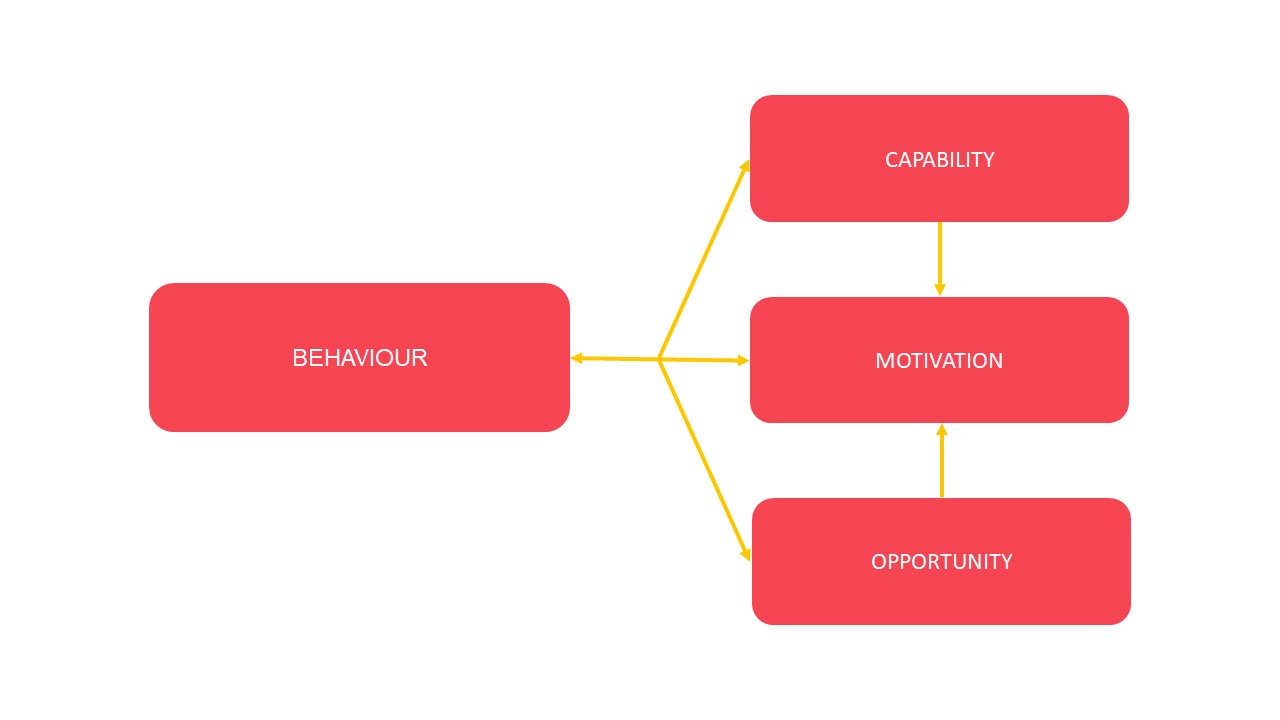
In summary, what each element of this model represent:
- Capability: The knowledge, skills, and abilities customers need to engage in a certain behaviour – includes both physical (e.g. body strength) and psychological (e.g. intelligence) capabilities
- Opportunity: The external factors that enable them to complete the behaviour – physical factors (e.g. money) and social factors (e.g. culture)
- Motivation: The reasons behind consumer behaviour
It’s important to note Capability and Opportunity influence and reinforce Motivation. They not only drive the behaviour itself, but push Motivation along too, having an even stronger additive effect on behaviour. Therefore, putting all marketing’s efforts into purely motivating customers isn’t effective. The real focus should be on increasing customers’ capabilities and opportunities to streamline their experience.
Choose the platform and tailor the message
As seen in the introduction of this article, social and digital channel usage varies significantly among demographics. Therefore, it’s key to pinpoint which channels your audience uses most. Then also understand the media that are growing fastest among these key audiences and build a presence before these platforms become saturated.
Furthermore, content analysis is fundamental as different channels suit different kinds of content. For example, TikTok content often joins genres and cultural cues to create new meaning while Instagram is used as a space where consumers share content to paint their lives in a positive light and striving for perfection. Streaming platforms, like Twitch, look to popular games and gamers as a source of inspiration to keep audiences engaged, especially in recent years where gaming has become a key channel for brands across most sectors (as we saw in last year article).
Furthermore, being aware of the trends on the different social platforms is key as well as answering to those in real time.
Offer a new level of transparency and traceability
The pandemic has only increased consumer demand for reliable information further. Despite regular updates offered by centralised information resources, consumers often look to other sources, including social media and their family/friends. Hence, the pressure on social media platforms to prevent and avoid misinformation being spread – especially given the high presence of news and conspiracy theories online.
In addition, there are many tools customers can use to find an answer in their quest for truth. Indeed, only in 2018, 31% of UK consumers had used a fact-checking website, up from 18% in 2017. Not everyone will be keen to know about a product’s backstory, but many will ask for deeper knowledge to be able to compare products and services. For instance, provenance, efficacy, corporate social responsibility – all could become as important to some customers as price.
This is a great opportunity for brands to communicate their offerings in a new way and, ultimately, differentiate from other businesses.
Questions
- How easy is it for your target customer to shop your offerings via digital channels and social media platforms?
- Can your brand facilitate transactions by meeting your consumers where they are?
- What influencer strategy would work for your brand to make it relevant and trustable to your audience?
- How could you collaborate with celebrities and influencers to hype product launches, generating a sense of exclusivity that drives wider purchasing?
Case Studies
Twitter enters the e-commerce world
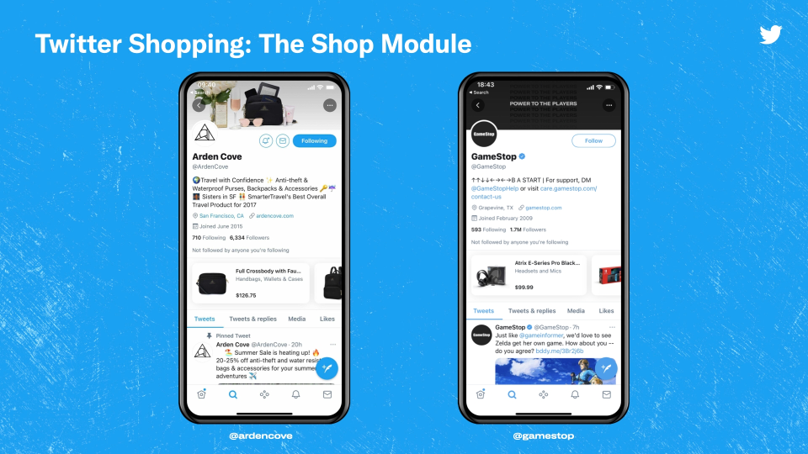
I belong Here: The Olympics: Tokyo 2020
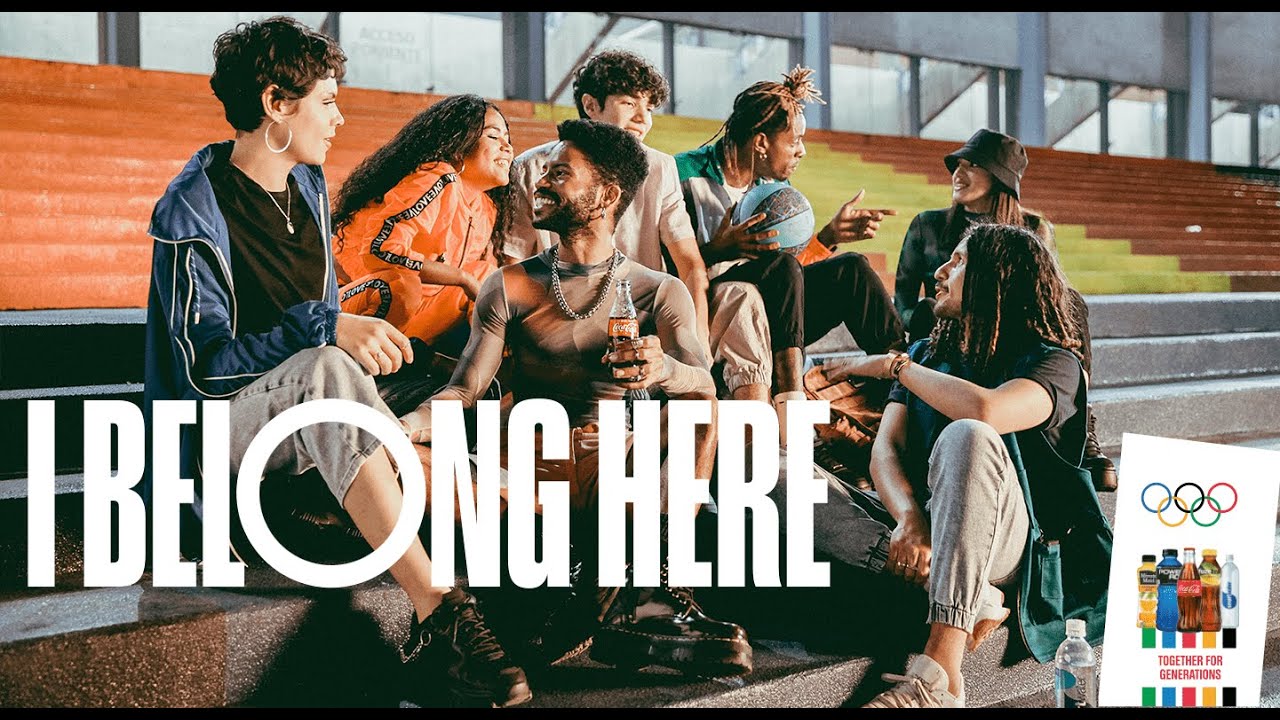
31 days - A record Twitch stream

Step partners with TikTok star
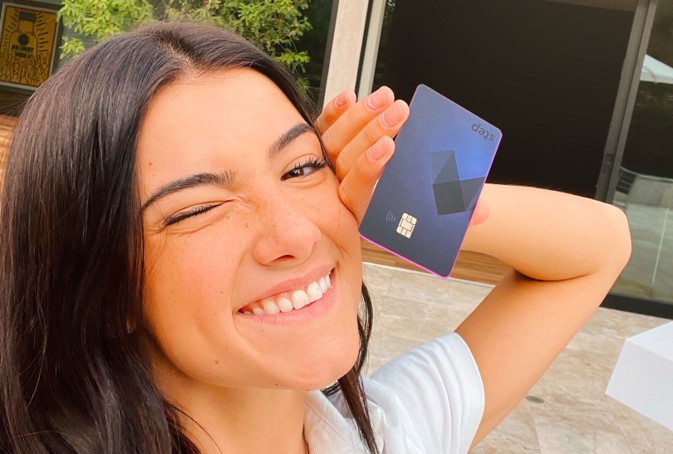
Methodology
‘Future Trends: Influence in the Age of SOcial Media’ is an initiative undertaken by the DMA in collaboration with dotdigital, Merkle and Salesforce and in partnership with Foresight Factory.
The report partially reviews data from the ‘Customer Engagement: Acquisition and the Customer Mindset 2021’. In addition, the DMA Insight department conducted desk research on industry trends, including the use of Foresight Factory’s FFonline platform.
If you have any questions about the insights or methodology used, you can contact the DMA’s Insight team via email: research@dma.org.uk.




Please login to comment.
Comments